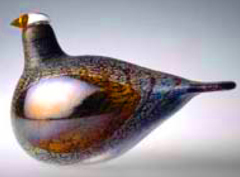OIVA TOIKKA
Award-Winning Finnish Glass Artist
by Joelle Steele
 For those who live outside of the art world, it is not unusual to think of decorative works of glass as anything other than artistic. But the movers and shakers of the "high art" institutions of the world did not even begin to embrace art glass as desirable or even acceptable forms of "real" art until well into the second half of the 20th century. This was good news for glass artists everywhere, including one of Finland's best-known designers, Oiva Toikka, famous for his Iittala collection of blown glass birds. His works are found not only in homes but in the collections of museums throughout the world.
For those who live outside of the art world, it is not unusual to think of decorative works of glass as anything other than artistic. But the movers and shakers of the "high art" institutions of the world did not even begin to embrace art glass as desirable or even acceptable forms of "real" art until well into the second half of the 20th century. This was good news for glass artists everywhere, including one of Finland's best-known designers, Oiva Toikka, famous for his Iittala collection of blown glass birds. His works are found not only in homes but in the collections of museums throughout the world.
Toikka (1931-2019) began his career in Helsinki where he trained as a ceramicist from 1953 to 1960. He worked as a designer of utility glassware and also as a professor at the Konstfackskolan (an art school) in Sweden and the University of Sunderland in Great Britain. He is still referred to by many as "Professor" Toikka.
 While those who are familiar with his work may think of him strictly in terms of his blown glass birds, Toikka was also a successful designer of costumes and stage sets for theater and opera. And while some may be eager to dismiss his blown glass birds as mere whimsy, this international artist was recognized by his peers for his creative endeavors. In 2001, he was awarded the Prins Eugen Medal by the King of Sweden for his life's work as an artist. Among his many other awards were the Lunning Prize and the Kaj Franck Prize.
While those who are familiar with his work may think of him strictly in terms of his blown glass birds, Toikka was also a successful designer of costumes and stage sets for theater and opera. And while some may be eager to dismiss his blown glass birds as mere whimsy, this international artist was recognized by his peers for his creative endeavors. In 2001, he was awarded the Prins Eugen Medal by the King of Sweden for his life's work as an artist. Among his many other awards were the Lunning Prize and the Kaj Franck Prize.
At Iittala's "glass village" in Nuutajärvi, Toikka used the famous colors from Kaj Franck's era to make his birds.
A disciplined craftsman and an expert in glass and glass working, Toikka actually invented many of the techniques used by him and his personally-trained team of glassblowers at Nuutajärvi. During that time, hundreds of different birds were crafted, and about 30 or so are still in production today, all part of the Birds by Toikka collection.
 Birds were always a source of inspiration to Toikka, and all of his birds were hand-made, mouth-blown glass – a significant talent in and of itself. But Toikka's birds also demanded a series of highly detailed and often small, seemingly insignificant movements to create the fine features and details that characterize his birds.
Birds were always a source of inspiration to Toikka, and all of his birds were hand-made, mouth-blown glass – a significant talent in and of itself. But Toikka's birds also demanded a series of highly detailed and often small, seemingly insignificant movements to create the fine features and details that characterize his birds.
Beginning his design from living examples, Toikka interpreted his birds in the highly stylized aesthetic of Nordic/Scandinavian design, which emphasized the fluid shape of birds, a characteristic that was so very well-adapted into glass. Each bird was completely unique in its features and coloration.

